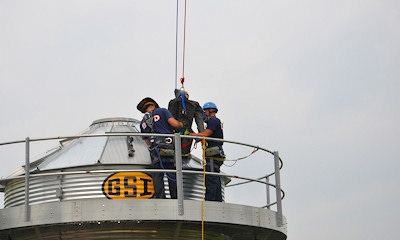
If statistics matter to you, Purdue University’s ag engineer and safety Extension specialist can make the case for staying out of grain bins with statistics. Purdue is in the fourth year of maintaining and updating the Purdue Agricultural Confined Space Incident Database made possible by a grant from the U.S. Department of Labor’s Susan Harwood Training Program.
The PACSID program tracks injuries and fatalities inside agricultural confined spaces from 1962 through 2015. It is a nationwide database. For 2015, Field says no fewer than 47 fatal and non-fatal cases were reported in agriculture. Of those 25 of the 47 cases were fatal. And 51% of all 47 cases involved grain entrapment.

POWERFUL FORCE: Flowing grain creates power. In this mock demonstration, once this person is buried to his waist, it would take about 325 pounds of force to free him.
Related: Grain bin entrapment simulator goes mobile
To understand why grain entrapment is so dangerous and why many grain entrapment cases are fatal, it’s important to understand the principles of grain flow, and the forces involved. It’s also important to know definitions used when training and discussing strategies to avoid grain bin entrapment in the first place.
Here is information that might convince you to think twice, and then think safety, when working around grain. If you need data and logical reasons to convince you it’s a dangerous activity, this information should grab your attention.
Definitions - engulfment vs. entrapment
Engulfment includes events in which an individual is submerged in grain, Field says. That means he is fully buried in an agricultural flowable material, such as corn, small grain or feed. Entrapment is a broader term describing events in which a person is trapped, possibly due to engulfment, in a structure or confined space. It might be inside a grain bin, silo, grain transport vehicle or bunker silo. The key is that ‘self-extrication,’ or getting yourself out by yourself, is not possible.
Definition - confined space
The brief definition is that a confined space in agriculture is an area large enough for a worker to enter to perform tasks, Field says. The space is not designed for continuous occupancy by the employee.
A flowable agricultural material is defined as simply a free-flowing crop or material. This definition includes grain.
Non-fatal incidents
If there are injuries in an entrapment but not death it is classified as a non-fatal incident. Many of these cases where death is not involved go unreported for various reasons. People involved in these, especially on farms, aren’t always eager to report them. Extension specialists believe that non-fatal incidents are underreported by a sizable amount.
Where entrapment occurs
According to data collected at Purdue before the PACSID program began, 45% of known entrapments involved corn. However, nationwide entrapments have been documented in soybeans, wheat, oats, sunflower, alfalfa seed, malted barley, milo, processed feed and rice. This hazard is not limited to grain farms. Some fatal cases over the past decade plus have occurred in Indiana in soybeans.
Causes of engulfment and entrapment
The number one cause of entrapment is out-of-condition grain. It’s one reason why grain bin safety becomes even more critical in years where grain of poor quality is harvested and binned in the fall. High-capacity grain handling systems are a second cause. A third cause is working alone. Working by yourself around grain bins is never a good idea, experts say.
Lack of knowledge concerning the risk of flowing grain is a fourth contributing factor.
Types of entrapment in grain situations
There are seven basic situations which can lead to entrapment: 1) flowing grain; 2) collapse of horizontally-crusted grain, 3) collapse of vertically crusted grain; 4) entrapment in grain transport vehicles, 5) Use of grain vacuum machines, 6) Avalanche of a pile of grain stored outside during removal of grain and 7) storage structure failure, or collapse of a bin.
Speed of entrapment
Based on a 10-inch auger unloading at a rate of 4,086 bushels per hour, a person can be nearly up to their waist in 15 seconds, fully under the grain surface in 30 seconds, buried to head level in 45 seconds and buried at 5 feet to top of head in 60 seconds. This information was provided by Liberty Rescue Systems, makers of rescue tubes for grain bin entrapment.
Force it takes to remove a person engulfed in grain
The amount of force that must be exerted depends upon the weight of the person and the depth at which they are buried. For example, if a 165 pound person is up to their waist in grain, it takes 325 pounds of force to free them. If they are submerged to their neck, it increases to 625 pounds. Once the head is covered, it rises to 800 pounds. By the time a 165 pound person is buried two feet deep to the top of the head, it would require 1,500 pounds of force to get them out. This data is also provided by Liberty Rescue Systems.
About the Author(s)
You May Also Like




